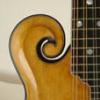Search the Community
Showing results for tags 'response'.
-
In the process of trying to figure out what a 4 Band Shift EQ is, I put my HD500 on the test bench and measured the frequency response of ALL the EQs in the HD500. I thought you'd find it useful so I'm sharing the results here. For example, what does a 100% shift mean? What does 0% Q mean? And just where is Freq = 38% in the Parametric EQ? Did you know when you set 2.2kHz of the Graphic EQ to -12dB you'll get a +12dB boost (!) at 1kHz before it dips down at 2.2kHz? No wonder it didn't work very well to eliminate a pesky feedback problem, but caused another one instead. Using these can give you insight into which EQ you really want to use. I've attached the most pertinent pictures here (zipped together to make it easy). The only potential problem is the 4 Band Shift Hi Freq which has mismatched L/R channels (~3dB at 1kHz)! Every other EQ and every other setting has perfect L/R balance (less than .1dB mismatch) but this one does not. I've contacted Line 6 support before submitting this here but they see nothing out of the ordinary (i.e., it sounds fine, which may be true, but there's still a mismatch, big enough to be called a bug in my opinion). I've labeled those two graphs channel 1 & 2 because that's what my test equipment calls them. Unfortunately I didn't have the forsight to find out which was left and which was right before I tore down the setup. But the fact of a mismatch remains. Some things you need to know to properly interpret these: An Audio Precision APx525 was used to generate the sound source and measure frequency response. Output = S/PDIF Input 1 = Mic. Input 2 = same. Mic level on back adjusted to give -20dBFS output with the Graphic EQ Unless otherwise indicated, the gain of all the other EQs were set to nominally give -20dBFS. The gains were recorded so you can see which EQs have built-in gain or loss compared to the Graphic EQ. There were no other FX or amps in the signal chain. Sample rate = 44.1kHz (factory default) I have more complete files that contain the actual data (not just pictures) as well as more settings than shown in these few pictures attached here. Until I can find a better place to put it, you can download the entire 160M set of Excel files from: https://dl.dropboxusercontent.com/u/56306778/HD500%20Measurements.zip. I am open to ideas of where to put this on a more permanent basis. Enjoy! I hope you find these as useful as I have. ---------------------------- I took the HD500 back into the lab and verified that it's the Left Channel that has the odd frequency response in the Hi Freq portion of the 4 Band Shift EQ. I re-uploaded the Excel files to indicate this and re-uploaded the new 4 Band Shift EQ figures here. ---------------------------- I measured the frequency response of the Q Filter (per meambobbo's post) and attached it here. I also updated the giant zip of Excel files. I think this could emulate a pretty Morley wah if you make toe = hi Freq/hi Q/hi Gain and heel = low Freq/low Q/ low Gain. Also, mix attempts to add the filtered signal to the straight signal, which it does. But the filtered signal has some processing delay so the mix includes some notches in the 4k-8kHz region you may not be expecting. You can see this in the attached graphs. For the signal levels I was using (-20dBFS thru the Graphic Equalizer) you can also see some gain compression with the Q filter. So if you want it clean, stick to the lower Gain levels. ----------------------------- Added a PDF file that lists the frequencies (in Hz) represented by the Parametric Frequency (in %). Updated links to ALL my measurement files: Amp Frequency Response Pre and Full (Excel) Cab DEP Parameters (Excel) Cabs with 121 Ribbon (Excel) Gains (Excel) Mic Frequency Response (Excel) Amp Tone Controls (pdf) Amp-Pre Frequency Response (pdf) Cab Frequency Response (pdf) FX Gain (pdf) Model Pak Frequency Response (pdf) Global EQ (zip) Huge 185M EQ frequency response file (zip) This last one was the original subject matter of this thread.
- 67 replies
-
- 28
-

-
There was a recent (now deleted) thread discussing what the Presence Control does and how it may enhance the sound. In an effort to add something productive to the discussion and to document how the various tone controls operate, I took my HD500 into the lab and measured the Frequency Response of various amplifiers. You can find the full report here (3M big, too big to attach here). A couple of points to note are mentioned in the front page of the summary as follows: Test setup: APx525 -> Guitar Input -> HD500 -> SPDIF Output -> APx525 Input level: -52dBV. This is very small but was required to keep the high gain amps in their linear region. SNR was still better than 60dB. HD500 settings: Inputs: Guitar/Variax Guitar: normal Channel Volume = 100% E.R. = 0% Drive level adjusted to give the best THD+N (usually below 0.2%) for the cleanest looking graphs No cabs (and therefore no mics, no Cab DEP parameters) Amp DEP settings: Master Volume = 100% Hum = 0% All other controls (Sag, Bias, Bias X): default values (50%) Tone controls were set to give the flattest reasonable response. As one control was varied, the others were kept at this “flat†setting. This doesn't represent a setting that necessarily "sounds good" but it provides a good starting point for comparisons. Also, the low level input allows the underlying frequency response of the amps to be seen. For larger signals, like guitar level signals, distortion terms will become more noticeable and add more high frequency content, perhaps making the amp sound different from what you may expect by looking at these graphs. So, use these just as a guide. Or use them to figure out what the controls do. Some are cuts, some are boosts, some are both. Some operate over a much wider frequency range than you'd expect. And now you can see what the FAC control does! Finally, I did not measure the effects of how these controls may effect the dynamic response of the amp. Adjusting them might effect the "feel" of the amp. I do not know. These measurements will not tell us. Enjoy, I hope you find them useful. ----------------------------------------------- Edited Jan18, 2018 to update Dropbox link.
-
So, one of the main things that led me to get rid of my PodXT Live was that, its compressors really really sucked. By the time you finally got the sustain right, the attack was sooo horrible that it was completely unusable. All I got was a wretched "thunk" sound on the attack - all bass and no highs. I've used guitar compressors for a long time and never had any of them do that except for some of the early Boss compressors. I hope that some of you can assure me to some degree that they, Line 6, have actually learned about how guitar compressors are supposed to sound like. This is my only trepidation about having ordered another Line 6 product. I also noticed that there's really only one guitar compressor being modeled. The MXR Dynacomp. They're workable but I do hope they'll give us more choices later on.
-
I've been trying those Taylor IRs for some days and they sure add an interesting flavor to what my variaxes can do by themselves, so I was wondering, does anybody have nylon/classical guitar impulse response files?
- 4 replies
-
- ir
- impulse response
- (and 4 more)
-
I took my HD500 in after upgrading it to 2.62 and measured the frequency responses of the Global EQ. I used an Audio Precision to generate a 100mV RMS signal into the Guitar input (set to Normal) and listen to the SPDIF output. I used a blank patch and panned Paths A/B to full L/R, respectively. Things aren't nearly as interesting as the FX EQs (plotted here for reference) because there are no % labels. Line 6 properly labeled the actual filter parameters and, based on my measurements, they did a pretty good job of getting them right. L/R balance is perfect. No surprises, although my measured Q was x2 what their label says. Not a big deal in my book. Still, attached here are half the graphs. Due to upload filesize limits I had to spread the plots out over two messages. The rest of the plots follow below.
- 31 replies
-
- 10
-

-
After seeing the interest expressed in my EQ frequency responses, I decided to take the HD500 back into the lab to measure gain. How much gain is there from the various inputs? How much gain thru the various EQ (my previous post lists some of that)? Perhaps look at gain thru some of the FX? Or maybe I shouldn't look at gain. I am soliciting other ideas to look at while I have it in the lab. Do any of you have any ideas?
- 1 reply
-
- hd500
- measurements
- (and 5 more)
-
Specifications and frequency response graphs can be found in the word document below: Line 6 Wireless Mic Specs.doc



